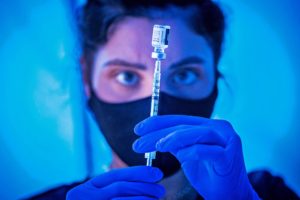As we enter our third Covid year, much of the world is getting back to normal. Denmark yesterday dropped most of its Covid restrictions and welcomed back “the life we knew before”. In the UK, face masks and Covid passports are no longer a legal requirement. Some US red states have passed laws against local mask mandates and vaccine requirements.
But in many of America’s deep-blue cities and suburbs, stringent Covid measures are still the norm, especially for schoolchildren. In New York City public schools, for instance, all students must wear masks at all times, including outdoors, except while eating or during designated “mask breaks”. Palo Alto, the hometown of Stanford University, makes kids wear mask outdoors at recess. And LA public schools, responding to new evidence about the uselessness of cloth masks, recently required children to wear surgical masks or N95/KN95s.
These measures are premised on the idea that America’s children must be shielded from exposure to Covid-19. What kids really need, however, is a return to normal. And when it comes to infectious disease, normality means a world where they are routinely exposed to, and overcome, viral illness. For children, getting sick and recovering is part of a natural and healthy life.
It has become common to criticise restrictions for children on the grounds that they harm mental health and social development. These concerns are valid, but it is important to emphasise that a more laissez-faire approach to kids and Covid makes public health sense, too. Dropping masks, quarantines, distancing, and all other mitigations will allow children to develop the kind of broad immunity gained by living a normal life.
Shielding kids from exposure only increases their future risk. This is partly why the UK does not vaccinate against chickenpox. Serious complications from the disease are rare among children, and the circulating virus allows adults to be naturally boosted against reactivation-driven shingles. By rebuilding population immunity among the least at-risk, moreover, we help buffer risk for those most vulnerable.
With Covid, the nadir of risk is between 5–11 years old — an age where children develop more robust and durable immunity from infection than adults, even with asymptomatic silent infections.
Some parents may think this sounds like a call to put their children at risk of serious illness or death. But it is important to remember that exposure to Covid-19 is inevitable. Vaccines protect against severe disease and side-effects such as MIS-C, but they cannot stop breakthrough infections, and the rapidity of Omicron’s spread suggests that no matter what we do, we cannot avoid the virus. In January, Anthony Fauci admitted as much, saying that Omicron will eventually “find just about everybody”.
The epidemiologist and researcher Francois Balloux puts it this way:
I'm not sure how to convey this message in a half-acceptable way. But, if the objective were to send SARCoV2 into endemicity, then healthy kids have to be exposed to the virus, ideally earlier than later. This is not 'eugenism'; it is bog-standard infection disease epidemiology.
— Prof Francois Balloux (@BallouxFrancois) January 26, 2022
This idea is not as frightening as it may sound. We know that even unvaccinated children generally do well after Covid-19 infection. A study from Germany found that among healthy, unvaccinated children aged 5–11 who became infected with the disease, just 8 in 100,000 ended up in the ICU and none died. Even children for whom vaccination is not yet an option are at lower risk now than they were last summer: the Omicron variant resulted in 66% fewer hospitalisations than Delta in a study of children younger than 5 years.
In some countries, this data informs policy. In Norway, for instance, parents of 5–11 year-olds can get vaccines for their children if they want them, but vaccines are only recommended for children with serious underlying conditions. This is not because vaccines are ineffective but because, according to the Norwegian Institute of Public Health, “the risk of a severe disease course at this age is small, and the need for vaccines for children and adolescents is limited”.
For children who are vaccinated, however, exposure at the lowest-risk age — roughly between kindergarten and middle school — could also be the safest way for young people to develop superior “hybrid” immunity. Last week, the CDC released a large study demonstrating that natural immunity is superior to vaccinated immunity and that hybrid immunity is superior to both. Vaccination provided a 19.8-times reduction in hospitalisation risk, but prior infection provided a 55.3-times reduction and a combination of the two conferred a 57.5-times reduction. Other studies suggest that hybrid immunity confers better cross-variant protection than vaccines alone.
And so schoolchildren, already at the lowest possible risk for severe Covid-19, have now exited what should be their last winter of restrictions. Many have already recovered from infection or been vaccinated, meaning that their risk has dropped from low to miniscule.
“Normal” has been an option for adults — it’s time to allow children to resume normal life, not simply because their exclusion is unfair or hurts them socially and psychologically, but because it is immunologically in their best interest. Parents must consider that exposures are how we best protect our children against the variants of the future. In fact, it is reckless to let children age into a more serious encounter with a disease best dealt with while younger.
This view is shared by the authors of a May 2021 paper in The British Journal of Medicine, who wrote: “Once most adults are vaccinated, circulation of SARS-CoV-2 may in fact be desirable, as it is likely to lead to primary infection early in life when disease is mild, followed by booster re-exposures throughout adulthood… This would keep reinfections mild and immunity up to date.” In fact, Norwegian authorities believe that natural infection will better protect children than vaccines that rely on out-of-date variants of the virus.
For parents worried that dropping restrictions will put their children at risk, the way forward is to realise that many of the protective measures we’ve been relying on, including masks — and especially the cloth masks that many American schoolchildren have been wearing for over a year — were never as protective as we’d thought, and are no match for omicron.
Some parents understandably fear the consequences of long Covid in kids, but the largest study to date is profoundly reassuring. Children who tested positive for Covid-19 were only 0.8% more likely to report long Covid symptoms, such as fatigue and muscle weakness, than those who had never tested positive. As the authors of the study concluded: “Long Covid in children is rare and mainly of short duration”.
Anxious parents should also put the risks in perspective. Children in many parts of Europe have been subject to less draconian restrictions than their US counterparts — without disastrous results. And while the death of any child is a tragedy, Covid-19 is less deadly to children than many other risks we accept as a matter of course, including drowning, vehicle accidents, and even cardiovascular disease.
Yes, diseases will continue to circulate, as they always have done. Schools are not sterile, nor should they be. Immunity is built through illness. If we can’t return our children to normalcy now, knowing what we know about the small risks facing children and the serious harms inflicted on them by pandemic-era restrictions, there is a real risk, at least in the more progressive parts of America, that the current arrangement will become the new normal. And that is a risk none of us should be willing to take.
Disclaimer
Some of the posts we share are controversial and we do not necessarily agree with them in the whole extend. Sometimes we agree with the content or part of it but we do not agree with the narration or language. Nevertheless we find them somehow interesting, valuable and/or informative or we share them, because we strongly believe in freedom of speech, free press and journalism. We strongly encourage you to have a critical approach to all the content, do your own research and analysis to build your own opinion.
We would be glad to have your feedback.
Source: UnHerd Read the original article here: https://unherd.com




